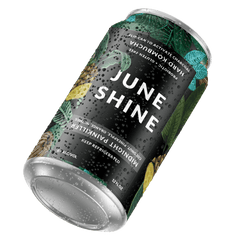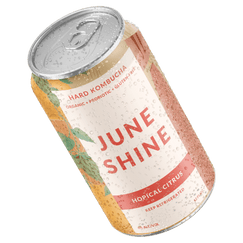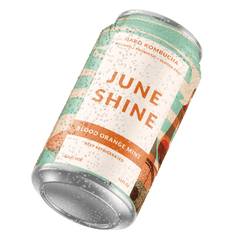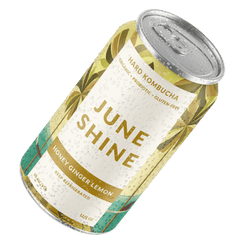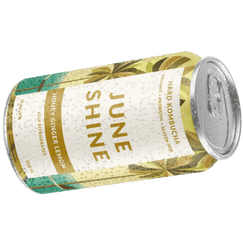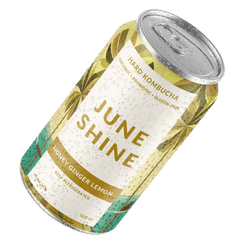Easy Step-by-Step Guide on How to Make Kombucha

These days, you can find kombucha on the shelf in almost every grocery store. From the wide variety of traditional kombuchas to bright, flavor-forward hard kombucha, this drink is making waves every day.
While you can buy kombucha in a store, some people like to get a little more hands-on. If you want to take your love for booch to the next level, try making it yourself at home. Read on if you’re ready for a little adventure, but be warned—you’ll have to get your hands dirty.
Kombucha’s Origin Story
Kombucha is a hot commodity now, but it’s been around for thousands of years—we’re talking over 2000.
There are plenty of legends surrounding kombucha, but most people believe kombucha came from China in 221 B.C. In fact, February 21 (or 2/21) is World Kombucha day, referencing its potential birthday. Kombucha was considered so powerful that it was titled “The Tea of Immortality.”
Some kombucha lovers believe the name comes from a Korean doctor named Kombu who brought the instructions for kombucha production to Japan. The tea eventually spread throughout the world from the far east to western Europe, which is how it ended up in your local grocery store today.
Kombucha’s Flavor Profile
Kombucha has a taste all its own. Smooth, slightly fruity, and perfectly tart, with just the right amount of fizz—it’s the refreshing sip you didn’t know you needed.
Since traditional kombucha is already so good, we figured it would be twice as good with a little extra buzz. We took the natural flavor of hard kombucha and created flavor combinations like Acai Berry, Hopical Citrus, and Blood Orange Mint. You get all the zing of traditional kombucha, with a lighter, brighter buzz and rich, botanical flavors.
Tips and Tricks for Brewing Kombucha
Before starting the kombucha brewing process, make a note of these tricks and tips:
- Use glass containers. Fermentation can erode metal because it produces acid, which can completely ruin your batch. Plastic containers are not ideal either because they can harbor bad bacteria (even after being washed) and leach chemicals into your brew.
- Keep your surfaces clean. You don’t want any bad bacteria entering your booch, so make sure that every surface and utensil you use is sparkling clean.
- Keep your kombucha in a warm environment. This will make the fermentation process go a little faster. Just don’t leave your booch in direct sunlight, as this can negatively affect fermentation.
- Keep your eyes open for mold. Look out for any green or black spots, and pay close attention to the smell of your kombucha. If it smells rancid, that’s a sign the batch isn’t good.
What Goes Into Kombucha?
Kombucha doesn’t require many ingredients, but the quality of your ingredients will majorly affect your batch. Traditional kombucha is usually made with:
- Yeast, kombucha starter, or existing SCOBY
- Sugar
- Tea—You can use black, green, or oolong, but we don’t suggest decaf tea.
- Water
When we’re making Junies, we use Jun Kombucha made with green tea and honey. This gives our booch a lighter, smoother flavor than black tea and sugar would provide. Hey, there’s a reason we’re called the champagne of kombuchas.
We also make sure that all of our ingredients are completely organic. You’ll never find pesticides, GMOs, or artificial colors and flavors in our booch because we’re all about the good stuff. You’ll know every single ingredient inside our kombucha before you try it—it’s almost like making your own, but with less work and more flavor.
If you’re aiming to make kombucha yourself, it’s worth keeping those parameters in mind when choosing your own ingredients.
SCOBY 101
SCOBY is an acronym that stands for symbiotic culture of bacteria and yeast. That’s a fancy way of saying that SCOBY is what makes fermentation possible.
If you plan on making your own SCOBY, keep these tips in mind:
- Don’t use decaf tea.
- Don’t mess with your SCOBY too much while it’s forming.
- Don’t be alarmed by visible changes to your SCOBY—it’s all part of the process.
What Tools Do You Need to Make Kombucha?
We already know kombucha is a three-ingredient blend. When it comes to supplies, you only need a few more items.
You’ll need:
- A large glass jug that fits all of your kombucha
- A measuring cup
- A wooden spoon for mixing
- Smaller glass jars or bottles that you can tightly close
How to Make Kombucha
Making kombucha isn’t the easiest process, but we’ll tell you how to do it anyway.
1. Make the Mixture
Start making SCOBY by creating sweet tea. First, bring water to a boil and dissolve sugar into it. Combine the water with the tea, and allow the tea bags to steep for about 20 minutes. Next, let the tea cool to room temperature because hot water might inhibit the SCOBY’s growth.
Add your kombucha starter or existing SCOBY to the tea with clean hands to avoid any unwanted bacteria. Cover with a cloth, coffee filter, or paper towel, and hold it in place with a rubber band. Leave the mixture in a warm location to ferment for one to four weeks.
2. The First Fermentation
Let's talk about the second step of making kombucha: fermentation.
Let your mixture sit for about one week before you check on it. You’ll hopefully see a new layer growing on the top like a membrane, as well as some bubbles and brown sediment on the bottom of your jar. This might seem a little funky, but that just means the fermentation process is hard at work.
3. The Second Fermentation
The second fermentation is when you can be creative in building the flavor and texture of your drink. In this step, the drink takes on its much-loved effervescence. For this stage, you only need two ingredients: the kombucha and a sweetener.
If you’re making the kombucha yourself, you’ll likely use cane sugar. However, here at JuneShine, we use pure, organic honey when making our kombucha for a smoother, easier-to-drink brew.
4. Time to Bottle
Once your kombucha is finished, it's time to pour it into different jars. Our top tip is to use a jar that seals to keep the carbonation from escaping. When pouring your booch into the jar, use a funnel for a cleaner pour.
The Benefits of Kombucha
One of the reasons traditional kombucha is so popular is because of its suspected benefits for the body.
Kombucha is packed with antioxidants because it’s made from tea. Specifically, you’ll find polyphenols in traditional kombucha, which are said to promote healthy gut and brain function.
Probiotics and the Gut
The probiotics that form as the tea ferments are also a major draw. Probiotics are healthy bacteria found in the gut that help balance good and bad bacteria in the gut. These probiotics support your immune system and even help you digest your food more effectively.
To fully understand the benefits of probiotics, we first need to understand the gut microbiome. This microbiome is composed of trillions of tiny bacteria, fungi, and viruses—also known as microbes. There are good bacteria and bad bacteria, and as long as you keep a balance between the two, you’re in good shape.
Your gut health is truly important to your well-being. Sure, it controls how you digest food, but it’s also potentially related to your overall immune health. Probiotics are one way to keep an eye on the balance of bacteria in your gut to make sure everything is running smoothly.
Take Your Kombucha One Step at a Time
While you might not want to make your own kombucha (and we don’t blame you, because this sounds like a lot of work), knowing how kombucha is made might shed some light on your favorite drink.
Sources:
2,000 years of kombucha: A very brief history of the world’s favorite fermented drink | vox
Green Tea vs. Black Tea: Which Is Healthier? | Healthline
Why the Gut Microbiome Is Crucial for Your Health | Healthline
Homemade Kombucha: The Simple Guide to Kickass Kombucha | Live Eat Learn
How to Make Kombucha - Easy Step by Step Instructions | Simple Life Mom
What Is SCOBY and How to Make Your Own Kombucha | Green Matters
How to Make Kombucha (A Beginners Guide!) | Brew Buch